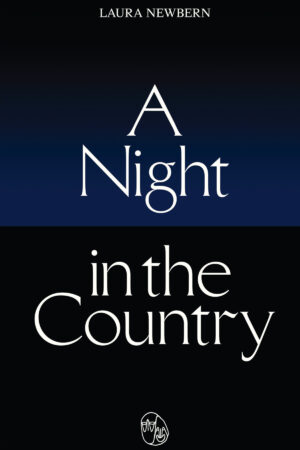A Night in the Country
by Laura Newbern
reviewed by Celeste Chen
Laura Newbern’s second collection, A Night in the Country, is a hypnotic yet exacting collection that chews on the process and the fruits of art-making and living. In this collection, a painting is not just a concrete image, but the culmination of successive ideas and studies. Newbern iterates and reiterates that the world still vibrates with the resonance of its past inhabitants, though they may hover out of reach.
The first poem, “Madonna of the Meadow,” opens with a quote from Albrecht Dürer on his fellow Renaissance painter Giovanni Bellini. “Giovanni,” Dürer writes, “is very old and yet he is the best painter of all.” With a painter’s eye, Newbern records the shifting image of the Madonna which Bellini “spent half his life” rendering: at first the Madonna and the child “glow in a box of dark” until Bellini “admits / to clouds in the world.” In later versions, the Madonna is seen in various configurations—with an apple, cupping her child:
Until at last, in 1500, he brings the girl
and her burden outside, onto a field: bleak trees
on the left, a ragged chorus of clouds stealing
behind them, more hills, and a far
tower, looking like where they used to be.
Throughout A Night in the Country, Newbern retraces this journey from a “box of dark” toward a place where the light is careful and constructed. In “Of the Mind,” Newbern’s speaker reflects on the days when Agatha Christie famously went missing—days for which Christie never provided an explanation:
There was her car, left at the lip of a pit, near a place
called the Silent Pool, which was said to be bottomless.
She was a suicide, said the papers. There was the car,
and the road, and the pit. There was even her dog—
brought to the scene, it stood there and whined.
And when Agatha Christie reappears once more:
………………………………….She was upright, lodged
at one of the bigger, brighter spas in the country
….
…………………………………………………….She was not
in the pit, not in the silent, bottomless pool.
And yet she was. Of course that was where she was.
Newbern’s poems wield light, titrating it through each line. In “Cliffs and Hills,” Newbern’s speaker is at a wax museum and describes scenes of John Brown’s final days. At first, the statue of John Brown “lies in a bed,” illuminated only by a ceiling light. Then, in the subsequent scene, Brown is in a room “blue as night.” Yet the poem ends not in the dark exhibition but outside it:
Life’s a room: outside it
two great rivers meet in sunlight;
cliffs rise up and turn to hills that roll away
like greenish waves; there is no help
in them. There’s only endless
blue-brown river.
Bristling day.
The idea that the backdrop to people’s lives might retain their stories or essence soon comes into focus. In the eponymous poem, the speaker recalls a memorial in the woods for a friend’s mother. Rather than simply reflecting on the event, she imagines the Quakers who may have once lived on the same land:
And the later, the darker it got, the more there were Quakers,
gray girls and boys and mothers and fathers, moving.
All they wanted was family, peace.
And from that, from that place, they were driven away.
Newbern revisits this sense of haunting—of a land waiting for its ghosts—in “Dürer’s Self Portrait.” The speaker first describes Dürer himself in a tower, sitting for himself, as “the young hare / and the squirrel / tend to the low / flora … ” before subsequently observing:
And in the tower window
are painted fields,
neat, Provencal,
and green hills,
and the one cloud
casting about
for a direction.
The hare and the squirrel
meanwhile—
meanwhile the pooling eyes
of the little owl—
everything says
Albrecht, one day
you too will head for the woods.
Agatha Christie was alive, but at one point she was in that imaginary darkness; she is now dead. Bellini’s Madonna of the Meadow is no longer the Madonna in the tower, but the former owes her arrangement to the latter. The hands of Giovanni Bellini and Albrecht Dürer have long since passed, but their paintings remain. In Newbern’s poems, the world is as much a haunted house for the inhabitants of the present as it is a home for the ghosts of the past.
Published on June 14, 2024

